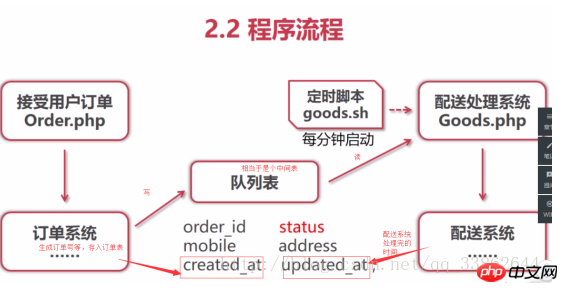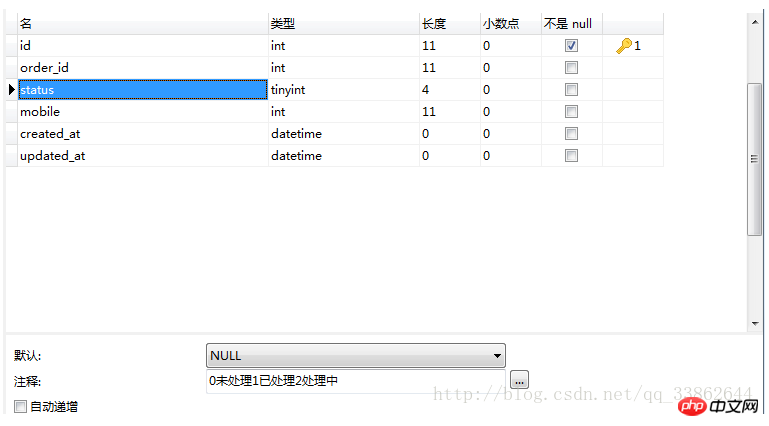 Backend Development
Backend Development
 PHP Tutorial
PHP Tutorial
 PHP queue processing: PHP message queue implementation principle (picture and text)
PHP queue processing: PHP message queue implementation principle (picture and text)
PHP queue processing: PHP message queue implementation principle (picture and text)
What does php queue mean? How is it achieved? What are the application scenarios? The following explains the implementation principle of PHP message queue in detail through the use of mysql to achieve decoupling and the use of redis to reduce traffic.
The concept of queue:
1. It is the middleware of the queue structure
2. After the message is put in, it does not need to be processed immediately
3,Processed by subscribers / consumers in order
Queue principle:

Just writeto the queueWrite, don’t worry about anything else, it doesn’t matter whether you can finish reading or not
Similarly ,Just read from the queue out , do the work when it comes, and rest when there is no work
Application scenarios:Redundancy:
Permanently stored in the queue, and subsequently obtained by the order processing program. After the processing is completed, the record is deleted Decoupling: yes decoupling These two systems (business and queue processing) are what we usually do. There is no direct relationship between the systems that enter the queue and the systems that exit the queue.
If one system fails, the other system will not be affectedbecause there is a queue in the middleThe traffic is reduced. Edge: Flash sales and rush sales. The traffic increased sharply, Use the message queue with the cache
(It is under the limit, for example, only 10 are allowed, and after 10 are stored in the queue, they will no longer be stored, and the flash sale will be prompted when it comes)Asynchronous communication: Because the message itself can cause the queued system to
return directly, it is said that the asynchronous operation of the program is realizedScenario scalability: such as
Now there are only order system and financial system. I want to add a distribution system in the future. Just let the distribution system subscribe to this queue directlySorting guarantee: some scenarios For example,
the processing order of bank data is very important, because the queue itself can be made into a single-threaded, single-input, single-out systemImplementation medium:
1. Using mysql: high reliability, easy to implement, slow speed2. Using redis: fast speed, single large message package Low efficiency
3. Use a more professional third-party class library: highly professional, reliable, and high learning cost.
Message processing triggering mechanism:1. Infinite loop reading: easy to implement, unable to reply in time in case of failure (Suitable for short periods such as flash sales )
2. Scheduled tasks: pressure is evenly distributed and has a processing upper limit (no matter how unstable the peak value of the system in front of your queue is, the system behind the queue will still execute it regularly )
Note: Timing time is the key: do not start the next scheduled task before the previous scheduled task is completed
Case: Order system, place an order After writing the order information into the queue, it immediately returns that the order was placed successfully. The distribution system reads the queue every few minutesregularly, and summarizes the orders
3. Daemon process: similar to php-fpm and cgi, requires shell basics (use this process to Check whether there is content in the queue. If there is content, start the dequeuing system for processing)
Use mysql to implement decoupling case:
Why decoupling: If the architecture is together. The order system is under great pressure, and logistics information does not need to be returned immediately. When orders collapse, logistics also collapses, so we need to decouple




Execute scheduled tasksCrontab -e

Note: This log file must be created by yourself

1. Access through the browser order.phpAdd order
2. Go to the database to see the results, and see the results in the log in shell ( The execution was not successful, maybe this sh file needs to be placed in a certain directory, and I will run it after the review is completed)
Using redis for traffic cutting case

Idea:
1. The flash sale program requests writing to redis
2. Check the length of the data stored in redis. If it exceeds the upper limit, it will be discarded directly (return to the end of the flash sale)
3. Infinite loop processing and storage in redis The data is merged into the database
Table design:

Flash sale code:

Storage code:

Browser direct access to user.php
atshell Use php -f savetodb.php
Go to the database to view
Related recommendations:
The above is the detailed content of PHP queue processing: PHP message queue implementation principle (picture and text). For more information, please follow other related articles on the PHP Chinese website!

Hot AI Tools

Undresser.AI Undress
AI-powered app for creating realistic nude photos

AI Clothes Remover
Online AI tool for removing clothes from photos.

Undress AI Tool
Undress images for free

Clothoff.io
AI clothes remover

Video Face Swap
Swap faces in any video effortlessly with our completely free AI face swap tool!

Hot Article

Hot Tools

Notepad++7.3.1
Easy-to-use and free code editor

SublimeText3 Chinese version
Chinese version, very easy to use

Zend Studio 13.0.1
Powerful PHP integrated development environment

Dreamweaver CS6
Visual web development tools

SublimeText3 Mac version
God-level code editing software (SublimeText3)

Hot Topics
 1657
1657
 14
14
 1415
1415
 52
52
 1309
1309
 25
25
 1257
1257
 29
29
 1229
1229
 24
24
 Explain JSON Web Tokens (JWT) and their use case in PHP APIs.
Apr 05, 2025 am 12:04 AM
Explain JSON Web Tokens (JWT) and their use case in PHP APIs.
Apr 05, 2025 am 12:04 AM
JWT is an open standard based on JSON, used to securely transmit information between parties, mainly for identity authentication and information exchange. 1. JWT consists of three parts: Header, Payload and Signature. 2. The working principle of JWT includes three steps: generating JWT, verifying JWT and parsing Payload. 3. When using JWT for authentication in PHP, JWT can be generated and verified, and user role and permission information can be included in advanced usage. 4. Common errors include signature verification failure, token expiration, and payload oversized. Debugging skills include using debugging tools and logging. 5. Performance optimization and best practices include using appropriate signature algorithms, setting validity periods reasonably,
 How does session hijacking work and how can you mitigate it in PHP?
Apr 06, 2025 am 12:02 AM
How does session hijacking work and how can you mitigate it in PHP?
Apr 06, 2025 am 12:02 AM
Session hijacking can be achieved through the following steps: 1. Obtain the session ID, 2. Use the session ID, 3. Keep the session active. The methods to prevent session hijacking in PHP include: 1. Use the session_regenerate_id() function to regenerate the session ID, 2. Store session data through the database, 3. Ensure that all session data is transmitted through HTTPS.
 How do you handle exceptions effectively in PHP (try, catch, finally, throw)?
Apr 05, 2025 am 12:03 AM
How do you handle exceptions effectively in PHP (try, catch, finally, throw)?
Apr 05, 2025 am 12:03 AM
In PHP, exception handling is achieved through the try, catch, finally, and throw keywords. 1) The try block surrounds the code that may throw exceptions; 2) The catch block handles exceptions; 3) Finally block ensures that the code is always executed; 4) throw is used to manually throw exceptions. These mechanisms help improve the robustness and maintainability of your code.
 Explain different error types in PHP (Notice, Warning, Fatal Error, Parse Error).
Apr 08, 2025 am 12:03 AM
Explain different error types in PHP (Notice, Warning, Fatal Error, Parse Error).
Apr 08, 2025 am 12:03 AM
There are four main error types in PHP: 1.Notice: the slightest, will not interrupt the program, such as accessing undefined variables; 2. Warning: serious than Notice, will not terminate the program, such as containing no files; 3. FatalError: the most serious, will terminate the program, such as calling no function; 4. ParseError: syntax error, will prevent the program from being executed, such as forgetting to add the end tag.
 What is the difference between include, require, include_once, require_once?
Apr 05, 2025 am 12:07 AM
What is the difference between include, require, include_once, require_once?
Apr 05, 2025 am 12:07 AM
In PHP, the difference between include, require, include_once, require_once is: 1) include generates a warning and continues to execute, 2) require generates a fatal error and stops execution, 3) include_once and require_once prevent repeated inclusions. The choice of these functions depends on the importance of the file and whether it is necessary to prevent duplicate inclusion. Rational use can improve the readability and maintainability of the code.
 PHP and Python: Comparing Two Popular Programming Languages
Apr 14, 2025 am 12:13 AM
PHP and Python: Comparing Two Popular Programming Languages
Apr 14, 2025 am 12:13 AM
PHP and Python each have their own advantages, and choose according to project requirements. 1.PHP is suitable for web development, especially for rapid development and maintenance of websites. 2. Python is suitable for data science, machine learning and artificial intelligence, with concise syntax and suitable for beginners.
 PHP: A Key Language for Web Development
Apr 13, 2025 am 12:08 AM
PHP: A Key Language for Web Development
Apr 13, 2025 am 12:08 AM
PHP is a scripting language widely used on the server side, especially suitable for web development. 1.PHP can embed HTML, process HTTP requests and responses, and supports a variety of databases. 2.PHP is used to generate dynamic web content, process form data, access databases, etc., with strong community support and open source resources. 3. PHP is an interpreted language, and the execution process includes lexical analysis, grammatical analysis, compilation and execution. 4.PHP can be combined with MySQL for advanced applications such as user registration systems. 5. When debugging PHP, you can use functions such as error_reporting() and var_dump(). 6. Optimize PHP code to use caching mechanisms, optimize database queries and use built-in functions. 7
 What are HTTP request methods (GET, POST, PUT, DELETE, etc.) and when should each be used?
Apr 09, 2025 am 12:09 AM
What are HTTP request methods (GET, POST, PUT, DELETE, etc.) and when should each be used?
Apr 09, 2025 am 12:09 AM
HTTP request methods include GET, POST, PUT and DELETE, which are used to obtain, submit, update and delete resources respectively. 1. The GET method is used to obtain resources and is suitable for read operations. 2. The POST method is used to submit data and is often used to create new resources. 3. The PUT method is used to update resources and is suitable for complete updates. 4. The DELETE method is used to delete resources and is suitable for deletion operations.



